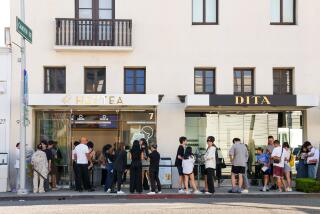Starbucks’ New Age Flavor Fitting to a Tea
- Share via
PORTLAND, Ore. — Starbucks Corp. has taught the nation a thing or two about coffee. When it comes to tea, however, the Seattle company is in learning mode.
Two years ago, Starbucks was struggling with its Infusia tea brand, but it couldn’t just drop tea from the menu because “every coffee shop has tea,” said Darren Huston, Starbucks’ senior vice president of new ventures.
Enter Tazo, a quirky tea experiment that began in founder Steve Smith’s kitchen in Portland seven years ago. Starbucks bought Tazo for $9.1 million in 1999, and in doing so has used a New Age aura to revive its tea fortunes.
Tea blends with names like Om, Zen and Awake now appear in every Starbucks coffeehouse. The individual teabags are stamped with tongue-in-cheek vignettes that describe the flavors in flowery prose.
Smith, who calls himself a “tea shaman,” has gone along his own path since leaving a 13-year career with competitor Stash Tea Co. in 1994.
He went door-to-door selling his teas before his company had a name. He described how he wanted each Tazo flavor to taste, then made them that way. He embraced bold and irregular ingredients--ginger, lemon grass, black pepper, cucumber juice, dried hibiscus flowers.
“I tasted teas and felt they should be stronger, guttier and more intense, while others needed to be subtler,” he said. “I wanted to take some risks, raise the bar.”
Tazo attracted attention from industry insiders long before Starbucks came along. It was a stand-out at food and beverage trade shows because of its unique packaging and Smith’s extensive knowledge of tea, market analysts said.
“Other tea companies have tried to copy New Age stuff and cutesy packaging,” said Brian Keating, a tea industry expert with Sage Group International in Seattle. “But Tazo’s packaging looks like a cross between 14th-century alchemy and an exotic tea estate somewhere. It’s masterful.”
Those unusual designs were what attracted Ann Irving to Tazo seven years ago, and she hasn’t stopped sipping it since.
“I don’t smoke, I rarely drink, I don’t drink soft drinks, but I do treat myself to wonderful tea,” said Irving, 52, who drinks two cups a day.
Smith’s expertise in traditional leaf teas, as well as herbal teas, means Tazo can succeed in both markets--a rarity among teamakers and a boon to Starbucks, experts said.
“Lots of people in the tea industry know black and green tea, or they’re herbal guys, but most don’t know both,” Keating said. Tazo’s three biggest competitors--Celestial Seasonings, Stash and The Republic of Tea--lack such flexibility, he said.
Starbucks has mixed Smith’s know-how with its deep pockets to turn tea into an endless array of tea-flavored drinks similar to its line of coffees.
“Tazoberry and Cream”--iced fruit tea and cream, topped with whipped cream--and spicy chai tea lattes are Starbuck’s most recent additions. The drinks sell for up to $4 a cup, more than some coffee drinks, while brewed iced tea and hot tea sell for up to $2.
Tea sales currently represent just 3 percent of Starbucks’ overall business--Starbucks stores sell an average of 18 chai tea lattes a day--but it is one of the company’s fastest-growing areas, Huston said.
“The Tazo mantra, even before it joined Starbucks, was to be the Starbucks of tea,” said Huston. “In five or 10 years, I think it could be as well-known as Starbucks coffee itself.”
Tazo recently moved into a 100,000-square-foot warehouse and instantly filled it with tons of dry tea, herbs and spices.
“We’ve got a tiger by the tail here,” Smith said. “To sell tea back to India, China and Taiwan is so neat. It gives me great pleasure.”
On the Net:
Starbucks Corp.: https://www.starbucks.com
Tazo Tea Co.: https://www.tazo.com
More to Read
Inside the business of entertainment
The Wide Shot brings you news, analysis and insights on everything from streaming wars to production — and what it all means for the future.
You may occasionally receive promotional content from the Los Angeles Times.









